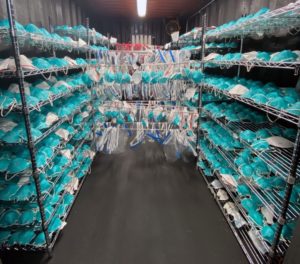
18 May Kenyon Alumna, Staff Member Steps Up to Help Fight Pandemic
In her role as Kenyon College’s associate director of institutional research, Ann Palcisco ’01 spends her days assessing the College’s programs and academic departments, surveying members of the Kenyon community, and providing information to Kenyon’s leaders to support data-driven decisions.
But when she heard that the Battelle Memorial Institute, a nonprofit science and technology development company based in Ohio, was developing a Critical Care Decontamination System (CCDS) to help allay the shortage of protective equipment for frontline healthcare workers fighting COVID-19, Palcisco was eager to help. She volunteered to take a leave of absence from her job at Kenyon, so she could work as one of the many technicians trained to operate the systems.
Palcisco, who majored in neuroscience at Kenyon, took a few moments during her deployment to answer our questions about her role in the project.
 What is your role with Battelle’s CCDS project?
What is your role with Battelle’s CCDS project?
I am a CCDS technician at the site in New Haven, Connecticut. Every day for three weeks I’ll be working a 12-hour shift receiving, processing, cleaning and shipping masks for hospitals, first-responders, long-term care facilities and state agencies from across Connecticut. Those clients pack up used masks and ship them across the state to our site. The decontaminating happens in big shipping containers, so I don some serious personal protective equipment (PPE) to unload and inspect each mask, then place it into the decon container. A few hours later, once we confirm the masks are clean and the container is safe to enter, I don a clean set of PPE and carefully package up the clean masks to send back to the client.
What inspired you to volunteer for this, and how did you get involved?
Even early on in the pandemic I was hearing from friends who worked in hospitals that supplies were running low and they were being asked to do more with less protection. They felt unsafe but were committed to doing their jobs in service of the rest of us. When I learned that Battelle had found a way to increase protection and needed to hire 2,000 people, I jumped at the chance to help and be of service to those tireless heroes. When I brought up taking a leave of absence to my bosses at Kenyon, they were immediately supportive and quickly helped figure out how to make it easy for me to be of service in this way.
How does the CCDS work and why is it important?
Battelle’s CCDS is a self-contained, readily deployable decontamination unit that uses vapor phase hydrogen peroxide to decontaminate thousands of N95 respirator masks each day. Battelle is working to build and deploy up to 60 systems to be located around the U.S., with FEMA and the Department of Health and Human Services determining where systems are placed for operation.
The system renders the SARS-CoV-2 virus non-infectious on N95 respirators and enables up to 20 reuses to help address the current PPE shortage. Decontamination is a stopgap measure — it is not meant to replace the need for more PPE for frontline healthcare workers, but it can extend and expand the use of current supplies to help keep healthcare personnel safe.






